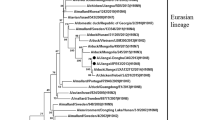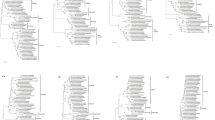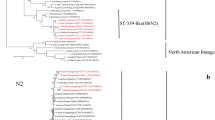Abstract
In May 2017, high mortality of chickens and Muscovy ducks due to the H5N8 highly pathogenic avian influenza virus (HPAIV) was reported in the Democratic Republic of Congo (DR Congo). In this study, we assessed the molecular, antigenic, and pathogenic features in poultry of the H5N8 HPAIV from the 2017 Congolese outbreaks. Phylogenetic analysis of the eight viral gene segments revealed that all 12 DR Congo isolates clustered in clade 2.3.4.4B together with other H5N8 HPAIVs isolated in Africa and Eurasia, suggesting a possible common origin of these viruses. Antigenically, a slight difference was observed between the Congolese isolates and a representative virus from group C in the same clade. After intranasal inoculation with a representative DR Congo virus, high pathogenicity was observed in chickens and Muscovy ducks but not in Pekin ducks. Viral replication was higher in chickens than in Muscovy duck and Pekin duck organs; however, neurotropism was pronounced in Muscovy ducks. Our data confirmed the high pathogenicity of the DR Congo virus in chickens and Muscovy ducks, as observed in the field. National awareness and strengthening surveillance in the region are needed to better control HPAIVs.


Similar content being viewed by others
References
Anis A, AboElkhair M, Ibrahim M (2018) Characterization of highly pathogenic avian influenza H5N8 virus from Egyptian domestic waterfowl in 2017. Avian Pathol 47:400–409
Basha HA, Abd el Naby WSH, Heikal HSM (2016) Genetic diversity and phylogenetic relationship among three duck breeds and geese using RAPD markers. Adv Anim Vet Sci 4:462–467
Bodewes R, Kuiken T (2018) Chapter twelve—changing role of wild birds in the epidemiology of avian influenza a viruses. In: Kielian M, Mettenleiter TC, Roossinck MJ (eds) Adv virus res. Academic Press, Cambridge, pp 279–307
Cai Z, Zhang T, Wan X-F (2012) Antigenic distance measurements for seasonal influenza vaccine selection. Vaccine 30:448–453
Chen Z, Liu X, Zhao M, Liu X, Zhu Y, Zhang Y, Liu W, Zhao K, Duan Z, Gu M, Zhao G, Peng D, Zhong L, Hu S (2013) Characterization of three H5N5 and one H5N8 highly pathogenic avian influenza viruses in China. Vet Microbiol. 163:351–357
Claes F, Morzaria SP, Donis RO (2016) Emergence and dissemination of clade 2.3.4.4 H5Nx influenza viruses - How is the Asian HPAI H5 lineage maintained. Curr Opin Virol. 16:158–163
Dong-Hun L, Justin B, Mia Kim T, Mary Lea K, Hon SI, Thomas JD, David ES (2016) Highly pathogenic avian influenza viruses and generation of novel reassortants, United States, 2014–2015. Emerg Infect Dis. 22:1283–1285
Donis RO, Smith GJD, Perdue ML, Brown IH, Chen H, Fouchier RAM, Kawaoka Y, Mackenzie J, Shu Y, Capua I, Cox N, Davis T, Garten R, Smith C, Guan Y, Vijaykrishna D, Mumford E, Russell CA, Smith D (2008) Toward a unified nomenclature system for highly pathogenic avian influenza virus (H5N1). Emerg Infect Dis 14:e1
WHO/OIE/FAO H5N1 Evolution Working Group (2009) Continuing progress towards a unified nomenclature for the highly pathogenic H5N1 avian influenza viruses: divergence of clade 2.2 viruses. Influenza Other Respir Viruses 3:59–62
Fourment M, Darling AE, Holmes EC (2017) The impact of migratory flyways on the spread of avian influenza virus in North America. BMC Evol Biol 17:118
Fusaro A, Monne I, Mulatti P, Zecchin B, Bonfanti L, Ormelli S, Milani A, Cecchettin K, Lemey P, Moreno A, Massi P, Dorotea T, Marangon S, Terregino C (2017) Genetic diversity of highly pathogenic avian influenza A(H5N8/H5N5) viruses in Italy, 2016-17. Emerg Infect Dis 23:1543–1547
Ghafouri SA, GhalyanchiLangeroudi A, Maghsoudloo H, Farahani RH, Abdollahi H, Tehrani F, Fallah MH (2017) Clade 2.3.4.4 avian influenza A (H5N8) outbreak in commercial poultry, Iran, 2016: the first report and update data. Trop Anim Health Prod 49:1089–1093
Grund C, Hoffmann D, Ulrich R, Naguib M, Schinköthe J, Hoffmann B, Harder T, Saenger S, Zscheppang K, Tönnies M, Hippenstiel S, Hocke A, Wolff T, Beer M (2018) A novel European H5N8 influenza A virus has increased virulence in ducks but low zoonotic potential. Emerg Microbes Infect 7:1–14
Hiono T, Okamatsu M, Matsuno K, Haga A, Iwata R, Nguyen LT, Suzuki M, Kikutani Y, Kida H, Onuma M, Sakoda Y (2017) Characterization of H5N6 highly pathogenic avian influenza viruses isolated from wild and captive birds in the winter season of 2016–2017 in Northern Japan. Microbiol Immunol 61:387–397
Kang HM, Lee EK, Song BM, Jeong J, Choi JG, Jeong J, Moon OK, Yoon H, Cho Y, Kang YM, Lee HS, Lee YJ (2015) Novel reassortant influenza A(H5N8) viruses among inoculated domestic and wild ducks, South Korea, 2014. Emerg Infect Dis 21:298–304
Khan Ahmadi A, Rahimi G, Vafaei A, Sayyazadeh H (2007) Microsatellite analysis of genetic diversity in Pekin (Anas platyrhynchos) and Muscovy (Cairina moschata) duck populations. Int J Poult Sci 6:378–382
Khomenko S, Abolnik C, Roberts L, Waller L, Shaw K, Monne I, Taylor J, Dhingra M, Pittiglio C, Mugyeom M, Roche X, Fredrick K, Kamata A, Okuthe S, Kone P, Wiersma L, Dobschuetz SV, Soumare B, Makonnen Y, Morzaria S, Lubroth J (2018) 2016–2018 Spread of H5N8 highly pathogenic avian influenza (HPAI) in sub-Saharan Africa: epidemiological and ecological. Food and Agriculture Organization of the United Nations Emerging Prevention System, Rome. FOCUS ON No. 12, Aug 2018
Kida H, Yanagawa R (1979) Isolation and characterization of influenza a viruses from wild free-flying ducks in Hokkaido, Japan. Zbt Bakt Hyg Orig A 244:135–143
Kimura M (1980) A simple method for estimating evolutionary rates of base substitutions through comparative studies of nucleotide sequences. J Mol Evol 16:111–120
Kumar S, Stecher G, Tamura K (2016) MEGA7: molecular evolutionary genetics analysis version 7.0 for bigger datasets. Mol Biol Evol 33:1870–1874
Lee D-H, Bertran K, Kwon J-H, Swayne DE (2017) Evolution, global spread, and pathogenicity of highly pathogenic avian influenza H5Nx clade 2.3.4.4. J Vet Sci 18:269–280
Moatasim Y, Kandeil A, Kayali G, Ali MA, McKenzie PP, Webby RJ, Kayed A (2017) Genetic characterization of highly pathogenic avian influenza A H5N8 viruses isolated from wild birds in Egypt. J Gen Virol 98:1573–1586
Ndumu D, Zecchin B, Fusaro A, Arinaitwe E, Erechu R, Kidega E, Kayiwa J, Muwanga E, Kirumira M, Kirembe G, Lutwama J, Monne I (2018) Highly pathogenic avian influenza H5N8 Clade 2.3.4.4B virus in Uganda, 2017. Infect Gen Evol 66:269–271
Nguyen LT, Nishi T, Shichinohe S, Chu D-H, Hiono T, Matsuno K, Okamatsu M, Kida H, Sakoda Y (2017) Selection of antigenic variants of an H5N1 highly pathogenic avian influenza virus in vaccinated chickens. Virology 510:252–261
Piersma T, Lindstrom A (2004) Migrating shorebirds as integrative sentinels of global. Ibis 146:61–69
Pohlmann A, Starick E, Harder T, Grund C, Hoper D, Globig A, Staubach C, Dietze K, Strebelow G, Ulrich RG, Schinkothe J, Teifke JP, Conraths FJ, Mettenleiter TC, Beer M (2017) Outbreaks among wild birds and domestic poultry caused by reassorted influenza A(H5N8) clade 2.3.4.4 viruses, Germany, 2016. Emerg Infect Dis 23:633–636
Reed LJ, Muench H (1938) A simple method of estimation of fifty per cent end-points. Am J Hyg 27:493–497
Selim AA, Erfan AM, Hagag N, Zanaty A, Samir A-H, Samy M, Abdelhalim A, Arafa A-SA, Soliman MA, Shaheen M, Ibraheem EM, Mahrous I, Hassan MK, Naguib MM (2017) Highly pathogenic avian influenza virus (H5N8) clade 2.3.4.4 infection in migratory birds. Egypt. Emerg Infect Dis 23:1048–1051
Smith DJ, Lapedes AS, de Jong JC, Bestebroer TM, Rimmelzwaan GF, Osterhaus ADME, Fouchier RAM (2004) Mapping the antigenic and genetic evolution of influenza virus. Science 305:371–376
Song C-S, Ip HS, Lee D-H, Winker K, Swayne DE, Torchetti MK (2015) Intercontinental spread of Asian-Origin H5N8 to North America through Beringia by Migratory Birds. J Virol 89:6521–6524
Sun H, Pu J, Hu J, Liu L, Xu G, Gao GF, Liu X, Liu J (2016) Characterization of clade 2.3.4.4 highly pathogenic H5 avian influenza viruses in ducks and chickens. Vet Microbiol 182:116–122
Twabela AT, Tshilenge GM, Sakoda Y, Okamatsu M, Bushu E, Kone P, Wiersma L, Zamperin G, Drago A, Zecchin B, Monne I (2018) Highly pathogenic avian influenza A(H5N8) virus, democratic republic of the Congo, 2017. Emerg Infect Dis 24:1371–1374
Uchida Y, Mine J, Takemae N, Tanikawa T, Tsunekuni R, Saito T (2019) Comparative pathogenicity of H5N6 subtype highly pathogenic avian influenza viruses in chicken, Pekin duck and Muscovy duck. Transboun Emerg Dis 66:1227–1251
Wade A, Jumbo SD, Zecchin B, Fusaro A, Taiga T, Bianco A, Rodrigue PN, Salomoni A, Kameni JMF, Zamperin G, Nenkam R, Foupouapouognigni Y, Abdoulkadiri S, Aboubakar Y, Wiersma L, Cattoli G, Monne I (2018) Highly pathogenic avian influenza A(H5N8) virus, Cameroon, 2017. Emerg Infect Dis. 24:1367–1370
Wilson IA, Skehel JJ, Wiley DC (1981) Structure of the haemagglutinin membrane glycoprotein of influenza virus at 3 Å resolution. Nature 289:366–373
World Organization for Animal H (2015) Update on highly pathogenic avian influenza in animals. pp 1-1 http://www.oie.int/animal-health-in-the-world-avian-influenza/2015/. Accessed 20 October 2018.
Yamamoto N, Sakoda Y, Motoshima M, Yoshino F, Soda K, Okamatsu M, Kida H (2011) Characterization of a non-pathogenic H5N1 influenza virus isolated from a migratory duck flying from Siberia in Hokkaido, Japan, in October 2009. J Virol 8:65
Acknowledgments
We gratefully acknowledge the Food and Agriculture Organization–Emergency Center for Transboundary Animal Disease, Kinshasa, the Democratic Republic of the Congo (ECTAD/FAO-CD), and the Japan Initiative for Global Research Network on Infectious Diseases (J-GRID), supported by the Japan Agency for Medical Research and Development (AMED), grant number JP18fm0108008, for greatly contributing to field sampling and shipments, respectively. This study was conducted under the doctoral program “Advanced Training Program for Fostering Global Leaders on Infectious Disease Control to Build Resilience against Public Health Emergencies” sponsored by the Japan International Cooperation Agency (JICA). We acknowledge the Global Initiative on the Sharing All Influenza Data and GenBank for the availability of sequences we used in this study.
Author information
Authors and Affiliations
Corresponding author
Ethics declarations
Conflict of interest
The authors declare that they have no conflict of interest.
Research involving animals
The animal experiments were approved by the Institutional Animal Care and Use Committee of the Faculty of Veterinary Medicine, Hokkaido University (approval numbers 16-0105 and 18-0037 for the antiserum preparation and the pathogenicity assessment, respectively). The experiments were performed according to the guidelines of the committee. The Faculty of Veterinary Medicine, Hokkaido University, is accredited by the Association for Assessment and Accreditation of Laboratory Animal Care International, which it has maintained since 2007.
Additional information
Handling Editor: William G Dundon.
Publisher's Note
Springer Nature remains neutral with regard to jurisdictional claims in published maps and institutional affiliations.
Electronic supplementary material
Below is the link to the electronic supplementary material.
Rights and permissions
About this article
Cite this article
Twabela, A.T., Okamatsu, M., Tshilenge, G.M. et al. Molecular, antigenic, and pathogenic characterization of H5N8 highly pathogenic avian influenza viruses isolated in the Democratic Republic of Congo in 2017. Arch Virol 165, 87–96 (2020). https://doi.org/10.1007/s00705-019-04456-x
Received:
Accepted:
Published:
Issue Date:
DOI: https://doi.org/10.1007/s00705-019-04456-x




